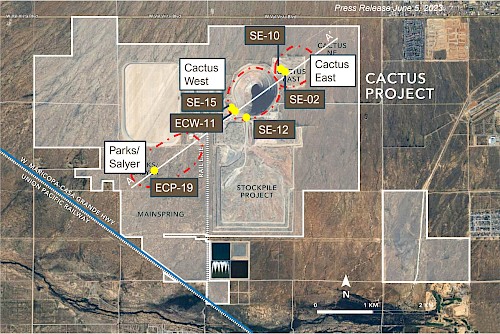
Arizona Sonoran Copper (TSX:ASCU) recently shared updates on their metallurgical testing from the Nuton Phase 1 column leach program at the Cactus copper porphyry project in Arizona. This testing forms part of the company’s evaluation of new technologies for copper extraction.
George Ogilvie, Arizona Sonoran Copper Company President and CEO commented in a press release: “We are encouraged by the extraction rates resulting from our primary and secondary sulphides using the Nuton™ technologies. These results demonstrate a continued extraction rate improvement from the columns reported in June. Nuton’s heap leaching technology is a potential solution to gain access to our currently stranded primary mineral resource while also incrementally improving the copper extraction rates from the enriched material. Particularly interesting to ASCU, is that Nuton’s flow sheet could be integrated into the planned Cactus heap leach and SXEW flow sheet. With a successfully negotiated Commercial Framework Agreement in place and a completed Phase 1 test program, we would seek to coordinate the improved extraction rates into an updated and expanded technical study, complementing the base case PFS anticipated in Q1 2024 and demonstrating economies of scale.”
The first phase of the program focused on assessing the efficiency of using Nuton’s proprietary additives in extracting copper from both primary and enriched sulphides at the Cactus site. The tests experimented with various operating conditions, such as temperature variations and different additive combinations. Following the Phase 1 results, ASCU and Nuton are considering moving to Phase 2, which aims to address the challenges and opportunities identified in the initial phase.
The Cactus deposit underwent 23 small-scale column leach tests, covering 10 different ore types and a Life of Asset (LoA) Blend. Early results suggest that Nuton additives, particularly at higher temperatures, could significantly improve chalcopyrite extraction in both the LoA blend and other primary sulphide ores. The highest copper extraction rate recorded for the LoA Blend was 80%. Efforts are ongoing to optimize conditions, especially temperature, to consistently exceed this extraction rate.
Acid consumption for processing primary sulfide ores varied widely, from 10 to 60 kilograms per tonne. For ores with higher acid consumption, adjusting the pH level showed mixed results, reducing acid use but also slowing down copper extraction. Nuton plans to continue its analysis, focusing on residue samples for additional insights. Extraction rates for secondary sulfide dominant ore types were notably high, ranging from 86% to 98%, attributed to the low reactive gangue content in these ores, making them net acid generators.
Highlights from the results are as follows:
- Phase 1: Indicative, interim results available at the end of November 2023, for first 15 small (3 ft | 1 m) columns completed:
- Targeting an average life of asset (“LoA”) copper extraction rate of 80% from the Cactus area material
- Primary sulphide as dominant material copper extractions at elevated temperatures range from 80% to 85%
- Secondary sulfide (“enriched”) as dominant material copper extraction at elevated temperatures range from 85% to +95%
- Phase 1: Next steps
- To conduct small column tests (3 ft | 1 m) on a Parks/Salyer primary blend and a mixed enriched blend sample
- Phase 2: Next Steps
- Metallurgical program contingent upon advancing a Commercial Framework agreement with Nuton
- To include tall column tests (30 ft | 10 m) on Cactus mineralized material to mitigate or test threats/opportunities identified under the Phase 1 test program
TABLE 1: Copper Extraction and Acid Consumption Estimates by Material Type
|
|
ASCU |
NUTON™ |
||||
|
|
Programs updated Feb 2022 and May 2023 |
Preliminary Column Data, updated November 2023 |
||||
|
Mineral Resource Location |
Net Copper Extraction (% Cu AS) |
Net Copper Extraction (% CuCN) |
Blended Extraction (%) |
Net Acid Consumption (kg/tonne) |
Extraction (%) |
Net Acid Consumption (kg/tonne) |
|
Oxides |
||||||
|
Stockpile |
90% 1 |
40% 1 |
81% |
81 |
n/a |
|
|
Cactus West |
92% 1 |
73% 1 |
88% |
81 |
|
|
|
Cactus East |
92% 1 |
73% 1 |
90% |
81 |
|
|
|
Parks Salyer |
|
|
|
|
|
|
|
Enriched (Secondary Sulphide) |
||||||
|
Cactus West |
92% 1 |
73% 1 |
78% |
(-) 5 |
86% – 98% |
-5 – 15 |
|
Cactus East |
92% 1 |
73% 1 |
76% |
(-) 5 |
86% – 98% |
-5 – 15 |
|
Parks Salyer |
|
|
80% |
(-) 5 |
80% |
-5 – 15 |
|
Primary Sulphides |
||||||
|
Flotation (ASCU) |
|
|
86% 2 |
(-) 5 |
n/a |
|
|
Leaching (Nuton) |
|
|
|
|
80% – 85% 3 |
10 – 45 |
|
Blended (Primary and Secondary Sulphide) |
||||||
|
Flotation (ASCU)/ |
|
|
91% 2 |
(-) 5 |
n/a |
|
|
Leaching (LoA) (Nuton) |
|
|
|
|
86% – 95% 4 |
25 – 404 |
|
1 As reported on February 23, 2022, Arizona Sonoran Updates on Metallurgical improvements at the Cactus Mine Project, acid consumption converted to kg/tonne from lbs/ton for comparison purposes |
||||||
|
2 Initial flotation results from 2022 testing program |
||||||
|
3 Excludes ASC 6 (ECW-011) that has anomalous high Biotite content (See Phase 2 workplan) |
||||||
|
4 Excludes column ASC 6 (ECW-011) that has anomalous high Biotite content and low temperature (See Phase 2 workplan) |
||||||
|
5 Net acid consumption is either nil or net generating |
||||||



 Follow us on Twitter
Follow us on Twitter Become our facebook fan
Become our facebook fan










Comments are closed.